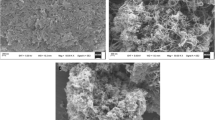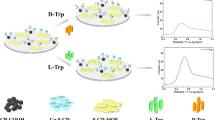Abstract
Based on the natural right-handed chirality of cellulose nanocrystals (CNCs) and conductive amplification of multiwall carbon nanotubes (MWCNTs), we designed a composite chiral sensor to discriminate the tryptophan (Trp) enantiomers with the advantages of rapid recognition, high sensitivity and stability. In comparison with previous reports, the developed composite sensor from s-CNC (CNC from H2SO4-hydrolysis)/MWCNT nanoparticles exhibited high enantiospecificity to l-Trp, with the promising sensitivity of 3.5-fold of the peak current ratio for l-Trp to d-Trp at the optimal conditions (pH 7.0, 25 °C). Two kinds of CNCs (s-CNCs from H2SO4-hydrolysis and h-CNCs from HCl-hydrolysis) bearing different surface properties (groups and charges) exhibited different effects on the affinity to Trp enantiomers and resultant chiral recognition influence. The synergetic effect of chiral recognition from cellulose nanocrystals and signal amplification from multiwall carbon nanotubes offered an easy-handling and effective electrochemical approach for isomers discrimination to realize the chiral recognition of Trp enantiomers.







Similar content being viewed by others
References
Ali I, Sanagi MM, Aboulenein HY (2014) Advances in chiral separations by nonaqueous capillary electrophoresis in pharmaceutical and biomedical analysis. Electrophoresis 35:926–936
Bao LP, Tao YX, Gu XG, Yang BZ, Deng LH, Kong Y (2016) Potato starch as a highly enantioselective system for temperature-dependent electrochemical recognition of tryptophan isomers. Electrochem Commun 64:21–25
Benesi HA, Hildebrand JH (1949) A spectrophotometric investigation of the interaction of iodine with aromatic hydrocarbons. J Am Chem Soc 71:2703–2707
Bi Q, Dong S, Sun Y, Lu X, Liang Z (2016) An electrochemical sensor based on cellulose nanocrystal for the enantioselective discrimination of chiral amino acids. Anal Biochem 508:50–57
Chen Y, Liu Y (2015) Construction and functions of cyclodextrin-based 1D supramolecular strands and their secondary assemblies. Adv Mater 27:5403–5409
Dalgliesh CE (1952) The optical resolution of aromatic amino-acids on paper. J Chem Soc 137:3940–3942
Engin AB (2015) Evaluation of tryptophan metabolism in chronic immune activation. Springer, Berlin, p 147
Gu XG, Tao YX, Yan P, Deng LH, Bao LP, Yong K (2015) DNA-inspired electrochemical recognition of tryptophan isomers by electrodeposited chitosan and sulfonated chitosan. Anal Chem 87:9481–9486
Guo LJ, Zhang Q, Huang YH, Han Q, Wang Y, Fu YZ (2013) The application of thionine-graphene nanocomposite in chiral sensing for tryptophan enantiomers. Bioelectrochemistry 94:87–93
Guo DM, Huang YH, Chen C, Chen Y, Fu YZ (2014) A sensing interface for recognition of tryptophan enantiomers based on porous cluster-like nanocomposite films. New J Chem 38:5880–5885
Hauser W, Mardirossian N, Panetier JA, Head-Gordon M, Bell AT, Schwerdtfeger P (2014) Functionalized graphene as a gatekeeper for chiral molecules: an alternative concept for chiral separation. Angew Chem Int Ed 53:9957–9960
Iizuka H, Ishii K, Hirasa Y, Kubo K, Fukushima T (2011) Fluorescence determination of d- and l-tryptophan concentrations in rat plasma following administration of tryptophan enantiomers using HPLC with pre-column derivatization. J Chromatogr B Analyt Technol Biomed Life Sci 879:3208–3213
Ikai T, Okamoto Y (2009) Structure control of polysaccharide derivatives for efficient separation of enantiomers by chromatography. Chem Rev 109:6077–6101
Kang SZ, Chen H, Li XQ, Mu J (2010) Preparation of l-alanine ethyl ester modified multiwalled carbon nanotubes and their chiral discrimination between d- and l-tryptophan. Diam Relat Mater 19:1221–1224
Lam H, Oh DC, Cava F, Takacs CN, Clardy J, Pedro MAD, Waldor MK (2009) d-amino acids govern stationary phase cell wall re-modeling in bacteria. Science 325:1552–1555
Lin N, Dufresne A (2014) Surface chemistry, morphological analysis and properties of cellulose nanocrystals with gradiented sulfation degrees. Nanoscale 6:5384–5393
Lin N, Huang J, Dufresne A (2012) Preparation, properties and applications of polysaccharide nanocrystals in advanced functional nanomaterials: a review. Nanoscale 4:3274–3294
Liu Y, Chen Y (2006) Cooperative binding and multiple recognition by bridged bis(β-cyclodextrin)s with functional linkers. Acc Chem Res 39:681–691
Moon RJ, Martini A, Nairn J, Simonsen J, Youngblood J (2011) Cellulose nanomaterials review: structure, properties and nanocomposites. Chem Soc Rev 40:3941–3994
Nie RQ, Bo XJ, Wang H, Zeng L, Guo LP (2013) Chiral electrochemical sensing for tyrosine enantiomers on glassy carbon electrode modified with cysteic acid. Electrochem Commun 27:112–115
Ou J, Tao YX, Xue JJ, Kong Y, Dai JY, Deng LH (2015a) Electrochemical enantiorecognition of tryptophan enantiomers based on graphene quantum dots–chitosan composite film. Electrochem Commun 57:5–9
Ou J, Zhu YH, Kong Y, Ma JF (2015b) Graphene quantum dots/β-cyclodextrin nanocomposites: a novel electrochemical chiral interface for tryptophan isomer recognition. Electrochem Commun 60:60–63
Ruddick JP, Evans AK, Nutt DJ, Lightman SL, Rook GA, Lowry CA (2006) Tryptophan metabolism in the central nervous system: medical implications. Expert Rev Mol Med 8:1–27
Song LX, Wang HM, Guo XQ, Bai L (2008) A comparative study on the binding behaviors of β-cyclodextrin and its two derivatives to four fanlike organic guests. J Org Chem 73:8305–8316
Song LX, Bai L, Xu XM, He J, Pan SZ (2009) Inclusion complexation, encapsulation interaction and inclusion number in cyclodextrin chemistry. Coord Chem Rev 253:1276–1284
Tao YX, Dai JY, Kong Y, Sha Y (2014) Temperature-sensitive electrochemical recognition of tryptophan enantiomers based on β-cyclodextrin self-assembled on poly( l -glutamic acid). Anal Chem 86:2633–2639
Tao YX, Gu XG, Deng LH, Qin Y, Xue HG, Kong Y (2015) Chiral recognition of d-tryptophan by confining high-energy water molecules inside the cavity of copper-modified β-cyclodextrin. J Phys Chem C 119:8183–8190
Tsang SC, Chen YK, Harris PJF, Green MLH (1994) A simple chemical method of opening and filling carbon nanotubes. Nature 372:159–162
Wang ZQ, Liu JD, Chen W, Bai ZW (2014) Enantioseparation characteristics of biselector chiral stationary phases based on derivatives of cellulose and amylose. J Chromatogr A 1346:57–68
Xu JJ, Wang QH, Xuan CZ, Xia Q, Lin X, Fu YZ (2016) Chiral recognition of tryptophan enantiomers based on β-cyclodextrin-platinum nanoparticles/graphene nanohybrids modified electrode. Electroanalysis 28:868–873
Yu XY, Yao ZP (2017) Chiral recognition and determination of enantiomeric excess by mass spectrometry: a review. Anal Chim Acta 968:1–20
Zhen QN, Xu B, Ma L, Tian G, Tang X, Ding M (2011) Simultaneous determination of tryptophan, kynurenine and 5-hydroxytryptamine by HPLC: application in uremic patients undergoing hemodialysis. Clin Biochem 44:226–230
Acknowledgments
This work was supported by the National Science Foundation of China (51603159) and the Natural Science Foundation of Shandong Province (ZR2016BM27). The authors also wished to acknowledge the financial support of Youth Chenguang Program of Science and Technology in Wuhan (2016070204010102) for this work.
Author information
Authors and Affiliations
Corresponding authors
Electronic supplementary material
Below is the link to the electronic supplementary material.
Rights and permissions
About this article
Cite this article
Zhang, Y., Liu, G., Yao, X. et al. Electrochemical chiral sensor based on cellulose nanocrystals and multiwall carbon nanotubes for discrimination of tryptophan enantiomers. Cellulose 25, 3861–3871 (2018). https://doi.org/10.1007/s10570-018-1816-1
Received:
Accepted:
Published:
Issue Date:
DOI: https://doi.org/10.1007/s10570-018-1816-1




